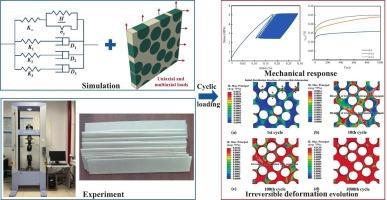Mechanical responses and microscopic irreversible deformation evolution of thermoplastic fiber-reinforced composites under cyclic loading
IF 6.8
2区 材料科学
Q1 ENGINEERING, MECHANICAL
引用次数: 0
Abstract
This research investigates the mechanical behavior and irreversible deformation mechanisms of thermoplastic fiber-reinforced composites. First, a nonlinear viscoelastic-elastoplastic constitutive model for the thermoplastic matrix was developed within a parallel rheological framework and calibrated using material tests. Subsequently, a three-dimensional representative volume element model, incorporating randomly distributed fibers and periodic boundary conditions, was established to accurately represent the composite microstructure. Composite specimens were fabricated and subjected to cyclic loading tests. By integrating experimental data with numerical simulations, the study analyzed the composite’s mechanical response under various cyclic loading conditions. Results indicate that stress level, stress ratio, and strain rate significantly influence the macroscopic mechanical response. Concurrently, material geometric features and multi-axial stress states substantially affect microscopic stress distributions and the evolution of irreversible deformation.

循环载荷下热塑性纤维增强复合材料的力学响应及微观不可逆变形演化
研究了热塑性纤维增强复合材料的力学性能和不可逆变形机理。首先,在平行流变框架内建立了热塑性基体的非线性粘弹弹塑性本构模型,并使用材料试验进行了校准。随后,建立了包含随机分布纤维和周期性边界条件的三维代表性体积元模型,以准确表征复合材料的微观结构。制作复合材料试件并进行循环加载试验。通过实验数据与数值模拟相结合,分析了复合材料在不同循环加载条件下的力学响应。结果表明,应力水平、应力比和应变速率对宏观力学响应有显著影响。同时,材料的几何特征和多轴应力状态对细观应力分布和不可逆变形的演化具有重要影响。
本文章由计算机程序翻译,如有差异,请以英文原文为准。
求助全文
约1分钟内获得全文
求助全文
来源期刊

International Journal of Fatigue
工程技术-材料科学:综合
CiteScore
10.70
自引率
21.70%
发文量
619
审稿时长
58 days
期刊介绍:
Typical subjects discussed in International Journal of Fatigue address:
Novel fatigue testing and characterization methods (new kinds of fatigue tests, critical evaluation of existing methods, in situ measurement of fatigue degradation, non-contact field measurements)
Multiaxial fatigue and complex loading effects of materials and structures, exploring state-of-the-art concepts in degradation under cyclic loading
Fatigue in the very high cycle regime, including failure mode transitions from surface to subsurface, effects of surface treatment, processing, and loading conditions
Modeling (including degradation processes and related driving forces, multiscale/multi-resolution methods, computational hierarchical and concurrent methods for coupled component and material responses, novel methods for notch root analysis, fracture mechanics, damage mechanics, crack growth kinetics, life prediction and durability, and prediction of stochastic fatigue behavior reflecting microstructure and service conditions)
Models for early stages of fatigue crack formation and growth that explicitly consider microstructure and relevant materials science aspects
Understanding the influence or manufacturing and processing route on fatigue degradation, and embedding this understanding in more predictive schemes for mitigation and design against fatigue
Prognosis and damage state awareness (including sensors, monitoring, methodology, interactive control, accelerated methods, data interpretation)
Applications of technologies associated with fatigue and their implications for structural integrity and reliability. This includes issues related to design, operation and maintenance, i.e., life cycle engineering
Smart materials and structures that can sense and mitigate fatigue degradation
Fatigue of devices and structures at small scales, including effects of process route and surfaces/interfaces.
 求助内容:
求助内容: 应助结果提醒方式:
应助结果提醒方式:


